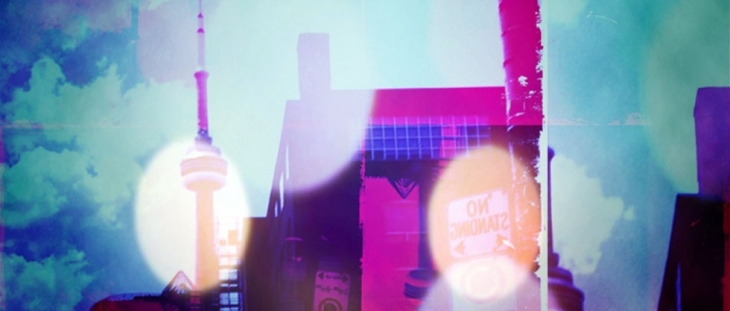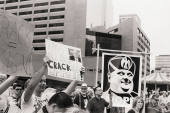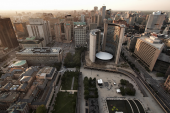
 Whatever happened to Torontopia? It was a term thrown around downtown Toronto all the time in the early-to-mid-aughts, not least by me. It was a mission to be contributed to, a phenomenon to be celebrated and a banner to be defended against cynics both inside and outside the city. It said that you didn’t have to look to New York or L.A. or London to find out what was exciting in the arts or urbanism or ideas, nor need you pump up Toronto’s always fragile self-esteem with blather about “world-class” whatchamacallit. Rather, the perfect city is already here, right in front of you, and all that’s lacking is for you to live as if that were true. It was variously linked with the Wavelength and Extermination Music concert series, the Trampoline Hall Lecture Series, literary events such as This Is Not a Reading Series, the opening of the Drake and Gladstone art hotels, countless bands such as the Hidden Cameras, Ninja High School, Final Fantasy and (more controversially) Broken Social Scene, theatre/performance groups such as Mammalian Diving Reflex and Small Wooden Shoe, record labels such as Three Gut, Arts & Crafts and Blocks Recording Club, small presses such as Coach House (with its “uTOpia” book series), activist groups such as the Toronto Public Space Committee and City Idol, the advent of the Nuit Blanche all-night arts event (but not Luminato), and so forth. It was name-checked in local and national media and even abroad by The New York Times, more than once (always the ultimate in Torontonian [without the “p”] affirmation). It stopped the bridge to the island airport, maybe. To the many, many people who reacted negatively to the term Torontopia, taking it for myopic centre-of-the-universe thinking, we replied that it was adaptable to any location: Your town could become Brantopia or Winnipetopia or Victopia or Halifatopia. As a purely imaginative condition (like any notion of utopia, which of course etymologically means “no place”), there were no limits to its supply. And thus it also seemed like something that, once claimed, we would always have. Until it became clear that somewhere along the way it had died. It perished perhaps of overexposure, perhaps of disappointment after hopes were raised too high, or even of its own success – the people most closely associated with it began to get jobs, shows or tours that kept them away from Toronto, while the people who were inspired by it took the city’s status as a crucible for exciting culture for granted, and would have found it a little weird and quaint to make the city their subject and their cause. If the coffin had not already been firmly shut, it felt to many of Torontopia’s former partisans that the 2010 election of Rob Ford sealed it with a nail gun. Somehow our age of enlightenment had prepared the way for a guy who would pave our pluralistic paradise and put up an infinitude of parking lots. Half a year later many of us are still either proclaiming the apocalypse or blaming ourselves (by which we really mean each other), floridly and self-righteously, for cliqueishness or failure to listen to the inner suburbs or whatever other karmic demerits we had racked up. Dave Meslin, who as the public face of the Toronto Public Space Committee was Torontopia’s prime unofficial emissary from the cultural sphere to the political realm, regularly posts on his blog extensive rationalizations of why Ford might prove to be good news and deserves good-faith collaboration. I admire Meslin’s willful open-mindedness but personally I think that in real economic, environmental and other practical terms, the Ford brothers are going to rain down havoc on this municipality like heavy-metal lords of petty-minded misrule, Boss Tweedledee and Boss Tweedledum. Still, they’ll be dancing on the grave of Torontopia only if we overlook the genuine cause of death – which wasn’t any of those mentioned above. Torontopia actually died of misunderstanding. Like Christianity, say, or America, its decline is due to amnesia about its real importance. In this way, Rob Ford does start to seem like a good thing, in a limited but soulfully vital sense, as the obstacle that forces us back onto the path less trodden and eroded. The term Torontopia was coined in jest in 2002 by some recent college graduates who were playing Fototag, a game in which one person runs through a public space, say the tunnel network of malls and bargain-luggage shops and food courts downtown, chasing a bunch of other players with a camera – anyone successfully photographed then becomes It. During it, one of them (exactly who is now forgotten) told the young artist and musician Steve Kado that he was thinking of starting a magazine called Torontopia, which would feature enthusiastic tributes to all the shitty, inadequate things about Toronto – its inherent dullness. Kado laughed and swiped the term to apply to the bands and other art projects he saw on the scene around him, which he considered kind of parasitical means of living on the wormy flesh of the traditional, bloated, self-doubting, bank-and-WASP-dominated, widely hated institutional weight of Toronto – then aptly misrepresented by Mayor “What Is the World Health Organization?” Mel Lastman. As Kado later told music journalist Michael Barclay, it was a punk, DIY, “our band could be your life” kind of rhetorical gesture, the kind of defiant but un-self-serious pride every hardcore punk community exercises when it proclaims in a fanzine that the Pittsburgh or Orange County scene is the best. In 2004, Kado and Blocks put out a compilation record called TORONTO IS THE BEST! full of groups shouting over Casio keyboards and iPod loops (not exclusively, but notably). There was a full-day launch show in a bike shop during which a comic pretended to be a high-school athletics coach, yelling at the audience to do calisthenics between bands. A lot of the songs were really great ones, but the conspicuous chintziness of many of the means of production ensured they radiated from a place of humility, maybe even humiliation. (The 2006 Bad Bands Revolution compilation took this another leap.) One of my favourite representations of that aesthetic was in local comedian and performance artist Jon McCurley’s 2009 play Double Double Land Land, in which Toronto was represented as a mediocre, mutated and impoverished place that was located right next to the wealthy and prosperous Tuba City, which is of course also Toronto – and, at a second level of meta-theatricality, the play ended when what the audience believed was a real wedding party in the building next door crashed the performance in tuxedos and party dresses and smashed champagne glasses all over the set. The creeping realization that the interruption was staged made me laugh longer than anything else in the past decade. The moral? We are our own worst enemies and, really, that’s the best thing we’ve got going for us. This double-double-edged aspect of Torontopia is the part that got forgotten. And the reason, I think, is that right in the midst of its inception and popularization, a confusing, counter-intuitive thing took place: In 2003, David Miller was elected mayor. No one anticipated a sympathetic-minded, arts-loving mayor (who would do things like take part in a debate at Trampoline Hall right in the middle of his campaign) vanquishing what was then a deeply corrupt City Hall (remember that scandal involving computers and stuff? it seems almost prehistoric, or at least pre-Facebook). Its coincidence with the Torontopian moment certainly helped spread the gospel, but it also distorted its course – our tongue-in-cheek cultural movement got all mixed up with the Jane Jacobs-quoting, organizing-and-lobbying stuff of standard progressive urban activism. All of that stuff is of course worthy and important and needs to be fought for in every city all the time. But it is different than the more perverse imp that is Torontopianism. That change of context made Blocks Recording Club’s slogan “Don’t try, do!” sound more like “Just do it,” when what it really meant was not to allow the near-certainty of “failure” to be a deterrent – do and fail, fail hard and big. It was about supplanting “productivity” with something more like processitivity, and participation for participation’s sake. It was anti-bystander, anti-consumer, anti-spectatorship. It was not built to win elections. Elections, of course, are gloriously un-utopian. This is their great virtue, but the continuous letdown that is democracy requires the subversively impractical counter-weight of utopian thinking if it is to be borne. Your utopia can never be lost to the pendulum swings of civic moods and political cycles and garbage strikes. It can only be neglected to death, especially in those infrequent and unlikely occasions when real life on the ground threatens to get really good and you actually start to believe that Toronto’s deep attachment to the half-assed is a thing of the past. On that level the Ford era is indeed our rebuke. But it’s also a welcome reminder that we’re still here, in the familiarly crappy heart of our half-assedness, which means that we are home, in the place that still relies upon us, its voluntary or involuntary children, to imagine it into being, a job no one else can or would want to do. Let them put some idiotic NFL stadium on the waterfront and more, more, more hideous condo buildings. As the poet Theodore Roethke wrote, “In a dark time, the eye begins to see.” And in these dark, idiotic times, will there also be singing? Yes, there will also be singing, about the idiotic times – probably into half-broken game consoles we scrounge at pawnshops. Appropriately enough Double Double Land is now not just an imaginary but a real location, a busy performance space hidden down an alleyway in Kensington Market, and everywhere in the city there are these obscure utopian efforts that will probably never set the world on fire but can be settings where we huddle together, fan the flames and enjoy our symptoms. May a million bloom, and wilt, and bloom. There, as Darren O’Donnell put it in his next-level-Torontopian 2005 one-man show A Suicide Site Guide to the City, “We will not refer to our revolutionary plans – but we will look at each other deep in the eyes and we will know who we are. And we will exchange email addresses. And we will build the future.”
Whatever happened to Torontopia? It was a term thrown around downtown Toronto all the time in the early-to-mid-aughts, not least by me. It was a mission to be contributed to, a phenomenon to be celebrated and a banner to be defended against cynics both inside and outside the city. It said that you didn’t have to look to New York or L.A. or London to find out what was exciting in the arts or urbanism or ideas, nor need you pump up Toronto’s always fragile self-esteem with blather about “world-class” whatchamacallit. Rather, the perfect city is already here, right in front of you, and all that’s lacking is for you to live as if that were true. It was variously linked with the Wavelength and Extermination Music concert series, the Trampoline Hall Lecture Series, literary events such as This Is Not a Reading Series, the opening of the Drake and Gladstone art hotels, countless bands such as the Hidden Cameras, Ninja High School, Final Fantasy and (more controversially) Broken Social Scene, theatre/performance groups such as Mammalian Diving Reflex and Small Wooden Shoe, record labels such as Three Gut, Arts & Crafts and Blocks Recording Club, small presses such as Coach House (with its “uTOpia” book series), activist groups such as the Toronto Public Space Committee and City Idol, the advent of the Nuit Blanche all-night arts event (but not Luminato), and so forth. It was name-checked in local and national media and even abroad by The New York Times, more than once (always the ultimate in Torontonian [without the “p”] affirmation). It stopped the bridge to the island airport, maybe. To the many, many people who reacted negatively to the term Torontopia, taking it for myopic centre-of-the-universe thinking, we replied that it was adaptable to any location: Your town could become Brantopia or Winnipetopia or Victopia or Halifatopia. As a purely imaginative condition (like any notion of utopia, which of course etymologically means “no place”), there were no limits to its supply. And thus it also seemed like something that, once claimed, we would always have. Until it became clear that somewhere along the way it had died. It perished perhaps of overexposure, perhaps of disappointment after hopes were raised too high, or even of its own success – the people most closely associated with it began to get jobs, shows or tours that kept them away from Toronto, while the people who were inspired by it took the city’s status as a crucible for exciting culture for granted, and would have found it a little weird and quaint to make the city their subject and their cause. If the coffin had not already been firmly shut, it felt to many of Torontopia’s former partisans that the 2010 election of Rob Ford sealed it with a nail gun. Somehow our age of enlightenment had prepared the way for a guy who would pave our pluralistic paradise and put up an infinitude of parking lots. Half a year later many of us are still either proclaiming the apocalypse or blaming ourselves (by which we really mean each other), floridly and self-righteously, for cliqueishness or failure to listen to the inner suburbs or whatever other karmic demerits we had racked up. Dave Meslin, who as the public face of the Toronto Public Space Committee was Torontopia’s prime unofficial emissary from the cultural sphere to the political realm, regularly posts on his blog extensive rationalizations of why Ford might prove to be good news and deserves good-faith collaboration. I admire Meslin’s willful open-mindedness but personally I think that in real economic, environmental and other practical terms, the Ford brothers are going to rain down havoc on this municipality like heavy-metal lords of petty-minded misrule, Boss Tweedledee and Boss Tweedledum. Still, they’ll be dancing on the grave of Torontopia only if we overlook the genuine cause of death – which wasn’t any of those mentioned above. Torontopia actually died of misunderstanding. Like Christianity, say, or America, its decline is due to amnesia about its real importance. In this way, Rob Ford does start to seem like a good thing, in a limited but soulfully vital sense, as the obstacle that forces us back onto the path less trodden and eroded. The term Torontopia was coined in jest in 2002 by some recent college graduates who were playing Fototag, a game in which one person runs through a public space, say the tunnel network of malls and bargain-luggage shops and food courts downtown, chasing a bunch of other players with a camera – anyone successfully photographed then becomes It. During it, one of them (exactly who is now forgotten) told the young artist and musician Steve Kado that he was thinking of starting a magazine called Torontopia, which would feature enthusiastic tributes to all the shitty, inadequate things about Toronto – its inherent dullness. Kado laughed and swiped the term to apply to the bands and other art projects he saw on the scene around him, which he considered kind of parasitical means of living on the wormy flesh of the traditional, bloated, self-doubting, bank-and-WASP-dominated, widely hated institutional weight of Toronto – then aptly misrepresented by Mayor “What Is the World Health Organization?” Mel Lastman. As Kado later told music journalist Michael Barclay, it was a punk, DIY, “our band could be your life” kind of rhetorical gesture, the kind of defiant but un-self-serious pride every hardcore punk community exercises when it proclaims in a fanzine that the Pittsburgh or Orange County scene is the best. In 2004, Kado and Blocks put out a compilation record called TORONTO IS THE BEST! full of groups shouting over Casio keyboards and iPod loops (not exclusively, but notably). There was a full-day launch show in a bike shop during which a comic pretended to be a high-school athletics coach, yelling at the audience to do calisthenics between bands. A lot of the songs were really great ones, but the conspicuous chintziness of many of the means of production ensured they radiated from a place of humility, maybe even humiliation. (The 2006 Bad Bands Revolution compilation took this another leap.) One of my favourite representations of that aesthetic was in local comedian and performance artist Jon McCurley’s 2009 play Double Double Land Land, in which Toronto was represented as a mediocre, mutated and impoverished place that was located right next to the wealthy and prosperous Tuba City, which is of course also Toronto – and, at a second level of meta-theatricality, the play ended when what the audience believed was a real wedding party in the building next door crashed the performance in tuxedos and party dresses and smashed champagne glasses all over the set. The creeping realization that the interruption was staged made me laugh longer than anything else in the past decade. The moral? We are our own worst enemies and, really, that’s the best thing we’ve got going for us. This double-double-edged aspect of Torontopia is the part that got forgotten. And the reason, I think, is that right in the midst of its inception and popularization, a confusing, counter-intuitive thing took place: In 2003, David Miller was elected mayor. No one anticipated a sympathetic-minded, arts-loving mayor (who would do things like take part in a debate at Trampoline Hall right in the middle of his campaign) vanquishing what was then a deeply corrupt City Hall (remember that scandal involving computers and stuff? it seems almost prehistoric, or at least pre-Facebook). Its coincidence with the Torontopian moment certainly helped spread the gospel, but it also distorted its course – our tongue-in-cheek cultural movement got all mixed up with the Jane Jacobs-quoting, organizing-and-lobbying stuff of standard progressive urban activism. All of that stuff is of course worthy and important and needs to be fought for in every city all the time. But it is different than the more perverse imp that is Torontopianism. That change of context made Blocks Recording Club’s slogan “Don’t try, do!” sound more like “Just do it,” when what it really meant was not to allow the near-certainty of “failure” to be a deterrent – do and fail, fail hard and big. It was about supplanting “productivity” with something more like processitivity, and participation for participation’s sake. It was anti-bystander, anti-consumer, anti-spectatorship. It was not built to win elections. Elections, of course, are gloriously un-utopian. This is their great virtue, but the continuous letdown that is democracy requires the subversively impractical counter-weight of utopian thinking if it is to be borne. Your utopia can never be lost to the pendulum swings of civic moods and political cycles and garbage strikes. It can only be neglected to death, especially in those infrequent and unlikely occasions when real life on the ground threatens to get really good and you actually start to believe that Toronto’s deep attachment to the half-assed is a thing of the past. On that level the Ford era is indeed our rebuke. But it’s also a welcome reminder that we’re still here, in the familiarly crappy heart of our half-assedness, which means that we are home, in the place that still relies upon us, its voluntary or involuntary children, to imagine it into being, a job no one else can or would want to do. Let them put some idiotic NFL stadium on the waterfront and more, more, more hideous condo buildings. As the poet Theodore Roethke wrote, “In a dark time, the eye begins to see.” And in these dark, idiotic times, will there also be singing? Yes, there will also be singing, about the idiotic times – probably into half-broken game consoles we scrounge at pawnshops. Appropriately enough Double Double Land is now not just an imaginary but a real location, a busy performance space hidden down an alleyway in Kensington Market, and everywhere in the city there are these obscure utopian efforts that will probably never set the world on fire but can be settings where we huddle together, fan the flames and enjoy our symptoms. May a million bloom, and wilt, and bloom. There, as Darren O’Donnell put it in his next-level-Torontopian 2005 one-man show A Suicide Site Guide to the City, “We will not refer to our revolutionary plans – but we will look at each other deep in the eyes and we will know who we are. And we will exchange email addresses. And we will build the future.”














